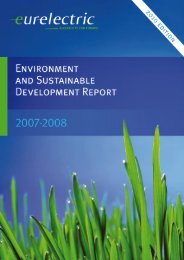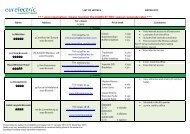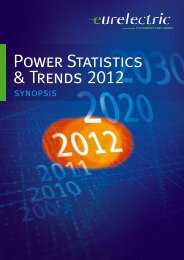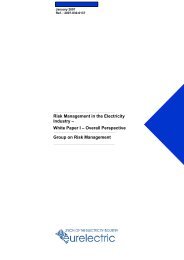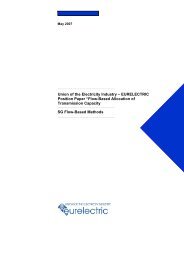European electricity industry views on charging Electric ... - Eurelectric
European electricity industry views on charging Electric ... - Eurelectric
European electricity industry views on charging Electric ... - Eurelectric
Create successful ePaper yourself
Turn your PDF publications into a flip-book with our unique Google optimized e-Paper software.
<str<strong>on</strong>g>European</str<strong>on</strong>g> <str<strong>on</strong>g>electricity</str<strong>on</strong>g> <str<strong>on</strong>g>industry</str<strong>on</strong>g> <str<strong>on</strong>g>views</str<strong>on</strong>g><br />
<strong>on</strong> <strong>charging</strong> <strong>Electric</strong> Vehicles<br />
--------------------------------------------------------------------------------------------------<br />
A EURELECTRIC positi<strong>on</strong> paper<br />
April 2011
The Uni<strong>on</strong> of the <strong>Electric</strong>ity Industry–EURELECTRIC is the sector associati<strong>on</strong> representing the<br />
comm<strong>on</strong> interests of the <str<strong>on</strong>g>electricity</str<strong>on</strong>g> <str<strong>on</strong>g>industry</str<strong>on</strong>g> at pan-<str<strong>on</strong>g>European</str<strong>on</strong>g> level, plus its affiliates and associates <strong>on</strong><br />
several other c<strong>on</strong>tinents.<br />
In line with its missi<strong>on</strong>, EURELECTRIC seeks to c<strong>on</strong>tribute to the competitiveness of the <str<strong>on</strong>g>electricity</str<strong>on</strong>g><br />
<str<strong>on</strong>g>industry</str<strong>on</strong>g>, to provide effective representati<strong>on</strong> for the <str<strong>on</strong>g>industry</str<strong>on</strong>g> in public affairs, and to promote the role of<br />
<str<strong>on</strong>g>electricity</str<strong>on</strong>g> both in the advancement of society and in helping provide soluti<strong>on</strong>s to the challenges of<br />
sustainable development.<br />
EURELECTRIC�s formal opini<strong>on</strong>s, policy positi<strong>on</strong>s and reports are formulated in Working Groups,<br />
composed of experts from the <str<strong>on</strong>g>electricity</str<strong>on</strong>g> <str<strong>on</strong>g>industry</str<strong>on</strong>g>, supervised by five Committees. This �structure of<br />
expertise� ensures that EURELECTRIC�s published documents are based <strong>on</strong> high-quality input with up-to-<br />
date informati<strong>on</strong>.<br />
For further informati<strong>on</strong> <strong>on</strong> EURELECTRIC activities, visit our website, which provides general informati<strong>on</strong><br />
<strong>on</strong> the associati<strong>on</strong> and <strong>on</strong> policy issues relevant to the <str<strong>on</strong>g>electricity</str<strong>on</strong>g> <str<strong>on</strong>g>industry</str<strong>on</strong>g>; latest news of our activities;<br />
EURELECTRIC positi<strong>on</strong>s and statements; a publicati<strong>on</strong>s catalogue listing EURELECTRIC reports; and<br />
informati<strong>on</strong> <strong>on</strong> our events and c<strong>on</strong>ferences.<br />
Dépôt légal: D/2011/12.205/6
<str<strong>on</strong>g>European</str<strong>on</strong>g> <str<strong>on</strong>g>electricity</str<strong>on</strong>g> <str<strong>on</strong>g>industry</str<strong>on</strong>g> <str<strong>on</strong>g>views</str<strong>on</strong>g> <strong>on</strong><br />
<strong>charging</strong> <strong>Electric</strong> Vehicles<br />
--------------------------------------------------------------------------------------------------<br />
Task Force <strong>Electric</strong> Vehicles<br />
Thomas THEISEN (DE) Chair<br />
Rui Filipe MARQUES (PT) Vice-Chair<br />
Federico CALENO (IT); Jose Manuel CORERA SANCHEZ (ES); David DENSLEY (GB); Esteban<br />
DIAZ EXPOSITO (ES); Anders Holm FOOSNAES (DK); Jesus GARCIA MARTIN (ES); Fernando<br />
GARCIA MARTINEZ (ES); Elvedin GRUDIC (NO); Fabien HILLAIRET (CZ); Gilles JEHAN (FR);<br />
Jiri KODAD (CZ); Valy LIOLIOU (GR); Senan McGRATH (IE); Philippe MEAN (CH); André<br />
POSTMA (NL); Hervé ROCHEREAU (FR); Rafael SANCHEZ DURAN (ES); Luis Manuel SANTOS<br />
MORO (ES); Gerd SCHAUER (AT); Paolo SCURO (IT); Ulrik STRIDBAEK (DK); Hendrik VAN<br />
ASBROECK (BE); Michael WELTIN (DE); Henrik WINGFORS (SE); Przemys�aw ZALESKI (PL)<br />
C<strong>on</strong>tact:<br />
Sophie TIELEMANS, Policy Officer � Networks Unit<br />
stielemans@eurelectric.org<br />
3
TABLE OF CONTENTS<br />
Key Message .....................................................................................................................5<br />
Introducti<strong>on</strong> ......................................................................................................................5<br />
2. Terminological clarificati<strong>on</strong> ...........................................................................................7<br />
2.1. Defining different <strong>charging</strong> methods ......................................................................7<br />
2.2. What is “smart” <strong>charging</strong>? .................................................................................... 10<br />
3. What are the benefits of smart <strong>charging</strong>? ................................................................... 11<br />
3.1. Preparing the <str<strong>on</strong>g>electricity</str<strong>on</strong>g> system for mass market electric vehicle applicati<strong>on</strong>s:<br />
generati<strong>on</strong> and grid capabilities .................................................................................. 11<br />
3.1.1. <strong>Electric</strong>ity generati<strong>on</strong> capacity ....................................................................... 11<br />
3.1.2. <strong>Electric</strong>ity grid capacity .................................................................................. 11<br />
3.2. Ensuring a cost-effective and customer-oriented <strong>charging</strong> infrastructure ............. 12<br />
3.2.1. The <strong>charging</strong> infrastructure for electric vehicles is already available .............. 12<br />
3.2.2. A c<strong>on</strong>venient <strong>charging</strong> opti<strong>on</strong> for customers.................................................. 13<br />
CONCLUSION .................................................................................................................. 14<br />
ANNEXES......................................................................................................................... 15<br />
4
Key Message<br />
Smart <strong>charging</strong> is indispensable to deliver the benefits of electric vehicles.<br />
Coordinating and managing electrical loads for <strong>charging</strong> electric vehicles will:<br />
Introducti<strong>on</strong><br />
- facilitate the integrati<strong>on</strong> of renewable energy sources into the <str<strong>on</strong>g>electricity</str<strong>on</strong>g> system;<br />
- enable grid management that introduces flexibility into the system;<br />
- optimise the efficient use of generati<strong>on</strong> capacity;<br />
- ensure a cost-effective soluti<strong>on</strong> by avoiding unnecessary grid investments;<br />
- maximise c<strong>on</strong>sumer c<strong>on</strong>venience through use of available infrastructure.<br />
EURELECTRIC is c<strong>on</strong>vinced that <str<strong>on</strong>g>electricity</str<strong>on</strong>g> is a soluti<strong>on</strong> for making transport more sustainable. Using<br />
low-carb<strong>on</strong> <str<strong>on</strong>g>electricity</str<strong>on</strong>g> in the transport sector can decrease greenhouse gas emissi<strong>on</strong>s, encourage<br />
energy-efficiency gains through the greater efficiency of electric drive-trains, decrease the EU’s oil<br />
dependence, improve the situati<strong>on</strong> in cities with regard to air polluti<strong>on</strong> and noise, and help to<br />
maintain the EU’s competitiveness by taking the lead in these new technological developments.<br />
Cross-<str<strong>on</strong>g>industry</str<strong>on</strong>g> understanding and cooperati<strong>on</strong> are needed to turn these opportunities into reality<br />
and foster the amalgam of c<strong>on</strong>diti<strong>on</strong>s that will ensure the success of this new transport technology.<br />
Reaping the full benefits of <str<strong>on</strong>g>electricity</str<strong>on</strong>g> as a transport fuel will require the efficient integrati<strong>on</strong> of<br />
electric vehicles into the <str<strong>on</strong>g>European</str<strong>on</strong>g> <str<strong>on</strong>g>electricity</str<strong>on</strong>g> system, with regard to both generati<strong>on</strong> and<br />
distributi<strong>on</strong>.<br />
The existing <str<strong>on</strong>g>European</str<strong>on</strong>g> <str<strong>on</strong>g>electricity</str<strong>on</strong>g> system already provides end-users with a very efficient<br />
infrastructure for generati<strong>on</strong>, transmissi<strong>on</strong>, distributi<strong>on</strong> and commercialisati<strong>on</strong> of <str<strong>on</strong>g>electricity</str<strong>on</strong>g>. The<br />
equilibrium of this very complex system is managed in real time, across all borders of Europe. While<br />
EURELECTRIC is c<strong>on</strong>vinced that the existing <str<strong>on</strong>g>European</str<strong>on</strong>g> <str<strong>on</strong>g>electricity</str<strong>on</strong>g> system is a true asset for making<br />
transport more sustainable, general recommendati<strong>on</strong>s for an optimal integrati<strong>on</strong> of electric mobility<br />
are important in order to avoid technical bottlenecks and unnecessary investments in the <str<strong>on</strong>g>electricity</str<strong>on</strong>g><br />
network.<br />
The commercial success of electric transport will, of course, largely depend <strong>on</strong> the customer.<br />
Comm<strong>on</strong> standards will help to ensure that drivers enjoy a c<strong>on</strong>venient re<strong>charging</strong> soluti<strong>on</strong> across<br />
Europe that avoids a multiplicity of different cables and adaptors and/or retrofit costs for adapting to<br />
new <strong>charging</strong> systems. Moreover c<strong>on</strong>sumers should be able to charge their vehicle at any publicly<br />
accessible <strong>charging</strong> stati<strong>on</strong> across Europe. A standardised interface between the distributi<strong>on</strong> grid and<br />
electric vehicles will ensure the required safety and security level for the c<strong>on</strong>sumer.<br />
Comm<strong>on</strong>ly agreed standards will generate cost benefits and help to create ec<strong>on</strong>omies of scale for<br />
both <str<strong>on</strong>g>electricity</str<strong>on</strong>g> companies and the automobile <str<strong>on</strong>g>industry</str<strong>on</strong>g>. Standards for both hardware (c<strong>on</strong>nectors<br />
and cables) and communicati<strong>on</strong> software are a prerequisite for a secure investment climate for the<br />
required infrastructure. As well as encouraging the sharing of development costs, such standards will<br />
help to avoid the risk of stranded assets resulting from interim soluti<strong>on</strong>s. However, these new<br />
standards should not make <strong>charging</strong> from domestic plugs more difficult, as this <strong>charging</strong> method<br />
facilitates early market introducti<strong>on</strong> of electric vehicles. In general, at the early stage of market<br />
development, it is important to leave room for further market improvements and refrain from<br />
overcomplicating market models and imposing a regulatory minefield.<br />
5
1. Policy background: standardisati<strong>on</strong> at the fore<br />
The <str<strong>on</strong>g>European</str<strong>on</strong>g> <str<strong>on</strong>g>electricity</str<strong>on</strong>g> <str<strong>on</strong>g>industry</str<strong>on</strong>g> welcomes the <str<strong>on</strong>g>European</str<strong>on</strong>g> Commissi<strong>on</strong>’s recogniti<strong>on</strong>, in its<br />
Communicati<strong>on</strong> <strong>on</strong> “a <str<strong>on</strong>g>European</str<strong>on</strong>g> Strategy <strong>on</strong> clean and energy efficient vehicles”, of the need<br />
for electric vehicle standardisati<strong>on</strong> and the identificati<strong>on</strong> of specific acti<strong>on</strong> fields in this<br />
regard. The Communicati<strong>on</strong> identifies the purpose of standards as follows: “to allow all<br />
electric vehicles to be charged and to communicate with the <str<strong>on</strong>g>electricity</str<strong>on</strong>g> grid anywhere in the<br />
EU and also with all types of chargers. Investment in electric <strong>charging</strong> points based <strong>on</strong><br />
different standards should be avoided as far as possible. Compatibility problems that prevent<br />
drivers from <strong>charging</strong> at any available point could undermine c<strong>on</strong>fidence in electric vehicle<br />
technology 1 ”.<br />
In June 2010, the <str<strong>on</strong>g>European</str<strong>on</strong>g> Commissi<strong>on</strong> mandated the <str<strong>on</strong>g>European</str<strong>on</strong>g> standardisati<strong>on</strong> bodies<br />
(CEN, CENELEC and ETSI) to develop <str<strong>on</strong>g>European</str<strong>on</strong>g> standards or to review existing standards in<br />
order to:<br />
- ensure interoperability and c<strong>on</strong>nectivity between the <str<strong>on</strong>g>electricity</str<strong>on</strong>g> supply point and the<br />
charger of electric vehicles, including the charger of their removable batteries, so<br />
that this charger can be c<strong>on</strong>nected and used in all EU member states. In doing so, the<br />
fact that domestic sockets are not harm<strong>on</strong>ised in the EU should be taken into<br />
account: adaptors should be used for domestic <strong>charging</strong>.<br />
- ensure interoperability and c<strong>on</strong>nectivity between the charger of electric vehicles – if<br />
the charger is not <strong>on</strong> board – and the electric vehicle and its removable battery, so<br />
that a single charger can be used to c<strong>on</strong>nect to and re-charge all types of electric<br />
vehicles and their batteries.<br />
- appropriately c<strong>on</strong>sider any smart-<strong>charging</strong> issue with respect to the <strong>charging</strong> of<br />
electric vehicles.<br />
- appropriately c<strong>on</strong>sider safety risks and electromagnetic compatibility of the charger<br />
of electric vehicles in the field of Directive 2006/95/EC (LVD) and Directive<br />
2004/108/EC (EMC).<br />
Following our Standardisati<strong>on</strong> Declarati<strong>on</strong> <strong>on</strong> electric vehicle <strong>charging</strong> infrastructure 2 ,<br />
EURELECTRIC, <strong>on</strong> behalf of the <str<strong>on</strong>g>European</str<strong>on</strong>g> <str<strong>on</strong>g>electricity</str<strong>on</strong>g> <str<strong>on</strong>g>industry</str<strong>on</strong>g>, agrees with the <str<strong>on</strong>g>European</str<strong>on</strong>g><br />
Commissi<strong>on</strong>’s identificati<strong>on</strong> of standardisati<strong>on</strong> as a specific acti<strong>on</strong> to “allow all electric<br />
vehicles to be charged and to communicate with the <str<strong>on</strong>g>electricity</str<strong>on</strong>g> grid anywhere in the EU”.<br />
EURELECTRIC will support and c<strong>on</strong>tribute to the <str<strong>on</strong>g>European</str<strong>on</strong>g> Commissi<strong>on</strong>’s mandate<br />
requesting CEN, CENELEC and ETSI to develop or review existing standards in order to<br />
ensure the interoperability of electric vehicles throughout Europe.<br />
1 Communicati<strong>on</strong> from the <str<strong>on</strong>g>European</str<strong>on</strong>g> Commissi<strong>on</strong> to the <str<strong>on</strong>g>European</str<strong>on</strong>g> Parliament, the Council and the <str<strong>on</strong>g>European</str<strong>on</strong>g><br />
Ec<strong>on</strong>omic and Social Committee, “A <str<strong>on</strong>g>European</str<strong>on</strong>g> Strategy <strong>on</strong> clean and energy efficient vehicles”, Brussels,<br />
28.04.2010, COM (2010)186 Final, p. 10.<br />
2 Declarati<strong>on</strong> by the <str<strong>on</strong>g>European</str<strong>on</strong>g> <str<strong>on</strong>g>electricity</str<strong>on</strong>g> <str<strong>on</strong>g>industry</str<strong>on</strong>g>, Standardisati<strong>on</strong> of electric vehicle <strong>charging</strong> infrastructure,<br />
EURELECTRIC, October 2009.<br />
6
Standardisati<strong>on</strong> requires full cooperati<strong>on</strong> of all stakeholders at the internati<strong>on</strong>al and<br />
<str<strong>on</strong>g>European</str<strong>on</strong>g> level in order to attain stable and comm<strong>on</strong>ly accepted standards. Keeping in mind<br />
the need to reach a rapid c<strong>on</strong>sensus <strong>on</strong> comm<strong>on</strong> <str<strong>on</strong>g>European</str<strong>on</strong>g> soluti<strong>on</strong>s, we propose that the<br />
CEN-CENELEC Focus Group <strong>on</strong> Electro-Mobility should be able to analyse and propose the<br />
technical soluti<strong>on</strong>s that seem best-suited to the <str<strong>on</strong>g>European</str<strong>on</strong>g> situati<strong>on</strong> in terms of<br />
interoperability and the optimum use of the electric infrastructure already in place.<br />
Recognising the leading role that the <str<strong>on</strong>g>electricity</str<strong>on</strong>g> <str<strong>on</strong>g>industry</str<strong>on</strong>g> has to play in this matter, this<br />
EURELECTRIC paper outlines several recommendati<strong>on</strong>s for turning plug-in electric and<br />
hybrid vehicles into a market success. The following secti<strong>on</strong> first clarifies some basic terms<br />
to facilitate a proper and clear understanding of the issues at hand.<br />
2. Terminological clarificati<strong>on</strong><br />
2.1. Defining different <strong>charging</strong> methods<br />
Much of the discussi<strong>on</strong> <strong>on</strong> electric vehicles (EVs) focuses <strong>on</strong> their range and <strong>charging</strong> times,<br />
particularly in c<strong>on</strong>trast to the relatively high range of internal combusti<strong>on</strong> vehicles and the<br />
quick filling of the car at a petrol stati<strong>on</strong>. Fuelling an electric vehicle means <strong>charging</strong> the<br />
battery. Hence the fuelling of an electric vehicle will depend <strong>on</strong> the combinati<strong>on</strong> of:<br />
- <strong>charging</strong> power (i.e. the voltage/amperage and the number of phases of the<br />
plug),<br />
- battery characteristics.<br />
We therefore feel that expressing the <strong>charging</strong> process in terms of power is more accurate<br />
than in time-related terms. In general <strong>on</strong>e could use the following classificati<strong>on</strong>:<br />
Power<br />
nominati<strong>on</strong><br />
Normal power 4<br />
Medium power<br />
High power<br />
High power<br />
Mains<br />
c<strong>on</strong>necti<strong>on</strong><br />
1-Phase AC<br />
c<strong>on</strong>necti<strong>on</strong><br />
1- or 3-phase<br />
AC c<strong>on</strong>necti<strong>on</strong><br />
3-phase AC<br />
c<strong>on</strong>necti<strong>on</strong><br />
DC c<strong>on</strong>necti<strong>on</strong><br />
Power in<br />
kW<br />
7<br />
Power in<br />
Amps<br />
Recharge<br />
range/hour 3<br />
≤ 3.7kW 10-16 amps 22 kW > 32 amps >110 km<br />
> 22 kW > 32 amps 5 >110 km<br />
3<br />
Assuming an average c<strong>on</strong>sumpti<strong>on</strong> of 20 kWh/100km.<br />
4<br />
This single phase c<strong>on</strong>necti<strong>on</strong> corresp<strong>on</strong>ds to the typical domestic plug c<strong>on</strong>necti<strong>on</strong> dependent <strong>on</strong> country<br />
specific characteristics.<br />
5<br />
With a DC c<strong>on</strong>necti<strong>on</strong> the power to the vehicle is fed at the vehicle battery DC voltage, which normally ranges<br />
from 150-350 volts, so the amperage is related to the DC power and voltage.
It should be noted, however, that there is a major difference in terms of usage between the<br />
normal and medium-power modes <strong>on</strong> the <strong>on</strong>e hand and the high-power mode <strong>on</strong> the other:<br />
whereas normal and medium power allow the cable to be loose, using high power means<br />
that the <strong>charging</strong> cable has a fixed c<strong>on</strong>necti<strong>on</strong> to the <strong>charging</strong> stati<strong>on</strong>.<br />
The <strong>charging</strong> method of electric vehicles will depend <strong>on</strong> where EV customers want to charge<br />
their vehicles. A strict, future-proof categorisati<strong>on</strong> is difficult. However, a general, simplified<br />
picture of usage could be imagined as follows:<br />
Normal power <strong>charging</strong> would generally take place in domestic settings like home and office<br />
buildings, but could also take place in public locati<strong>on</strong>s like curb-side <strong>charging</strong> poles and<br />
public car parks.<br />
Figure 1 is an example of a vehicle <strong>charging</strong> and using its <strong>on</strong>board charger at normal power<br />
level. The <strong>on</strong>board charger can be compared to a high power mobile ph<strong>on</strong>e charger, as it<br />
also normally relies <strong>on</strong> a high frequency transformer to make it compact and lightweight and<br />
is unidirecti<strong>on</strong>al in power transformati<strong>on</strong>. This charger is part of the vehicle and allows it to<br />
charge at any normal socket.<br />
Existing or new public or<br />
private socket - outlet<br />
Supply Network<br />
AC<br />
AC AC C<strong>on</strong>troller DC<br />
Engine (inverter)<br />
Batteries<br />
Figure 1 – The picture shows the main EV comp<strong>on</strong>ents involved in <strong>charging</strong> and locomoti<strong>on</strong>. When <strong>charging</strong><br />
at normal power level, the <strong>on</strong>board charger receives AC power and transforms it into DC <strong>on</strong> the way to the<br />
battery. The power from the <strong>on</strong>board charger can range between 1.5 and 3.5kW. The c<strong>on</strong>troller of the<br />
vehicle drive train c<strong>on</strong>verts DC energy from the battery to AC energy to feed the AC engine. The c<strong>on</strong>troller is<br />
composed of a bidirecti<strong>on</strong>al inverter, as it also regenerates energy from braking back to the battery, using<br />
the engine as a generator. Some electric vehicles use DC instead of AC engines, in which case the c<strong>on</strong>troller<br />
is simply a DC-DC c<strong>on</strong>verter.<br />
8<br />
AC Vehicle<br />
Socket - inlet<br />
AC<br />
Onboard<br />
charger<br />
DC
Medium power with a <strong>on</strong>e- or three-phase AC c<strong>on</strong>necti<strong>on</strong> would be used by customers who<br />
park their vehicle while shopping or in a parking lot in a city area. A high-power 3-phase AC<br />
infrastructure can be erected <strong>on</strong> public roads to be used by EV customers who park their car<br />
<strong>on</strong> a public street. Figure 2 is an example of how <strong>charging</strong> at the power level could work.<br />
Existing or new public or<br />
private socket - outlet<br />
Supply Network<br />
AC<br />
AC AC C<strong>on</strong>troller DC<br />
Engine (inverter)<br />
Batteries<br />
Figure 2 – The picture displays the <strong>charging</strong> scenario for either medium or high power AC <strong>charging</strong>. In this<br />
case the vehicle can use either a high power <strong>on</strong>board charger for currents higher than 16A, or use the drive<br />
train c<strong>on</strong>troller inverter (with additi<strong>on</strong>al comp<strong>on</strong>ents) to achieve the c<strong>on</strong>versi<strong>on</strong> of AC energy into DC energy<br />
to the battery. In that case the vehicle could be able to charge at a power equivalent to the engine power,<br />
for example 75kW for a 100 horse powered vehicle.<br />
A high power DC c<strong>on</strong>necti<strong>on</strong> would satisfy customer expectati<strong>on</strong>s for l<strong>on</strong>ger journeys, for<br />
instance when they would like to c<strong>on</strong>tinue a motorway journey after a relative short<br />
re<strong>charging</strong> stop. Figure 3 provides an illustrati<strong>on</strong> of this example.<br />
New public or private charge spot<br />
Supply Network<br />
External Charger<br />
DC<br />
Figure 3 - Example of a high power DC charge using an external charger which c<strong>on</strong>verts AC power from the<br />
grid to DC voltage and current appropriate to the vehicle battery. The charger is directly c<strong>on</strong>nected to the<br />
battery but the voltage and current are c<strong>on</strong>trolled by the vehicle Battery Management System (BMS), which<br />
tells the charger what to do in each instant of the <strong>charging</strong> sessi<strong>on</strong>.<br />
9<br />
AC<br />
AC Vehicle<br />
Socket - inlet<br />
AC<br />
Onboard<br />
charger<br />
DC Vehicle Socket - inlet<br />
Onboard<br />
charger<br />
AC C<strong>on</strong>troller<br />
DC<br />
DC<br />
AC<br />
DC<br />
Engine (inverter)<br />
Batteries<br />
DC
The <strong>charging</strong> power levels outlined above are related to different modes of <strong>charging</strong>, as<br />
defined in IEC standard IEC61851 for c<strong>on</strong>ductive <strong>charging</strong> of EVs. Mode 1 is defined as<br />
c<strong>on</strong>necting the vehicle to the supply network or mains, utilising a standardised socket outlet<br />
at the supply side, with single or three-phase, neutral and protective earth c<strong>on</strong>ductors.<br />
Charging Mode 3 uses dedicated <strong>Electric</strong> Vehicle Supply Equipment (EVSE), with a dedicated<br />
socket outlet for <strong>charging</strong> the vehicle and also includes a c<strong>on</strong>trol-pilot functi<strong>on</strong>ality for<br />
additi<strong>on</strong>al safety. Mode 2 is an intermediate soluti<strong>on</strong> to charge a Mode 3 vehicle <strong>on</strong> a<br />
standardised socket outlet not dedicated to EVs. For this to be possible, the <strong>charging</strong> cable is<br />
fitted with an In-Cable C<strong>on</strong>trol Box (ICCB) at the cable supply side ending, allowing it to act<br />
as an EVSE. From the ICCB a standardised plug is then used to c<strong>on</strong>nect to the standardised<br />
socket outlet. Finally, Mode 4 is defined as an indirect c<strong>on</strong>necti<strong>on</strong> to the mains using an<br />
EVSE. An example of this is DC <strong>charging</strong> where the DC charger is c<strong>on</strong>nected to the mains and<br />
then feeds the vehicle with DC voltage and current directly to the vehicle battery.<br />
A great deal of discussi<strong>on</strong> and work in the standardisati<strong>on</strong> bodies and between EURELECTRIC<br />
members has developed around the implementati<strong>on</strong> of Mode 3 and the public utilisati<strong>on</strong> of<br />
Mode 1 to charge electric vehicles, as it is a very important subject for standardisati<strong>on</strong> and<br />
the market take-up of electric vehicles.<br />
EURELECTRIC believes that all class M and N vehicles coming into the market should be<br />
fitted with Mode 3 <strong>charging</strong>. Mode 3 is a safer and more reliable opti<strong>on</strong> to charge an EV in<br />
all available locati<strong>on</strong>s and should be the preferred l<strong>on</strong>g-term infrastructure soluti<strong>on</strong>. In order<br />
to facilitate EV market penetrati<strong>on</strong>, a transitory phase, depending <strong>on</strong> the market take-up,<br />
should be allowed in which existing infrastructure can be used in a safe way. Mode 2<br />
<strong>charging</strong> (a Mode 3 vehicle <strong>charging</strong> at an existing socket with an ICCB) is an example of safe<br />
<strong>charging</strong> and should be allowed during the transitory phase at least in private locati<strong>on</strong>s. The<br />
same applies to other safe <strong>charging</strong> cases with existing Mode 1 EVs .<br />
2.2. What is “smart” <strong>charging</strong>?<br />
EURELECTRIC has defined smart <strong>charging</strong> as follows: “smart <strong>charging</strong> refers to a c<strong>on</strong>trolled<br />
<strong>charging</strong> process that optimises the use of the grid and the available electrical energy to<br />
minimise additi<strong>on</strong>al investments in the grid and facilitate the integrati<strong>on</strong> of RES.” The c<strong>on</strong>trol<br />
mechanism can be enabled by the grid, by the <strong>charging</strong> point or by the vehicle itself, while a<br />
communicati<strong>on</strong> system with the grid allows the <strong>charging</strong> process to take actual grid<br />
capabilities into account. Price or c<strong>on</strong>trol signals can be communicated through an ICT<br />
infrastructure (e.g. intelligent metering system) in order to allow intelligent <strong>charging</strong><br />
algorithms to take generati<strong>on</strong> and grid c<strong>on</strong>straints into c<strong>on</strong>siderati<strong>on</strong> and to allow the<br />
c<strong>on</strong>sumer to benefit from price opportunities.<br />
10
3. What are the benefits of smart <strong>charging</strong>?<br />
The <str<strong>on</strong>g>European</str<strong>on</strong>g> <str<strong>on</strong>g>electricity</str<strong>on</strong>g> <str<strong>on</strong>g>industry</str<strong>on</strong>g> deems it indispensable to charge electric vehicles in a<br />
smart way. Coordinating and managing the loads will:<br />
- facilitate the integrati<strong>on</strong> of renewable energy sources into the <str<strong>on</strong>g>electricity</str<strong>on</strong>g> system<br />
specially with regard to decentralised generati<strong>on</strong> c<strong>on</strong>nected to the distributi<strong>on</strong> grid;<br />
- enable grid management that introduces flexibility into the system;<br />
- optimise the efficient use of generati<strong>on</strong> capacity;<br />
- ensure a cost-effective soluti<strong>on</strong> by avoiding unnecessary grid investments;<br />
- maximise c<strong>on</strong>sumer c<strong>on</strong>venience through use of available infrastructure.<br />
3.1. Preparing the <str<strong>on</strong>g>electricity</str<strong>on</strong>g> system for mass market electric vehicle<br />
applicati<strong>on</strong>s: generati<strong>on</strong> and grid capabilities<br />
3.1.1. <strong>Electric</strong>ity generati<strong>on</strong> capacity<br />
Given the energy and climate goals set by the <str<strong>on</strong>g>European</str<strong>on</strong>g> Uni<strong>on</strong> in 2009, <str<strong>on</strong>g>electricity</str<strong>on</strong>g> generati<strong>on</strong><br />
is to change drastically. Renewable energy sources (RES) will become a significant part of the<br />
EU <str<strong>on</strong>g>electricity</str<strong>on</strong>g> generati<strong>on</strong> mix. Moreover the <str<strong>on</strong>g>European</str<strong>on</strong>g> <str<strong>on</strong>g>electricity</str<strong>on</strong>g> <str<strong>on</strong>g>industry</str<strong>on</strong>g> has set itself the<br />
challenging objective of achieving a carb<strong>on</strong>-neutral power supply by 2050.<br />
Changing generati<strong>on</strong> sources affect the transmissi<strong>on</strong> and distributi<strong>on</strong> of <str<strong>on</strong>g>electricity</str<strong>on</strong>g>. RES<br />
differ significantly from c<strong>on</strong>venti<strong>on</strong>al <str<strong>on</strong>g>electricity</str<strong>on</strong>g> sources due to their volatility, which causes<br />
peaks in the <str<strong>on</strong>g>electricity</str<strong>on</strong>g> grid. Bi-directi<strong>on</strong>al communicati<strong>on</strong> between electric vehicles and<br />
<strong>charging</strong> spots is therefore necessary to streamline demand and the available <str<strong>on</strong>g>electricity</str<strong>on</strong>g>.<br />
This bi-directi<strong>on</strong>al communicati<strong>on</strong> enables c<strong>on</strong>trolled <strong>charging</strong> procedures: the vehicle will<br />
be charged “off peak” and utilising available grid capacity. Smart <strong>charging</strong> therefore not <strong>on</strong>ly<br />
enables optimal use of RES capacity, but is also indispensable to avoid additi<strong>on</strong>al demand for<br />
<str<strong>on</strong>g>electricity</str<strong>on</strong>g>, which would in turn require additi<strong>on</strong>al generati<strong>on</strong> capacity, especially during<br />
peak times. Indeed, electric vehicle applicati<strong>on</strong>s could be used as an enabler for future bidirecti<strong>on</strong>al<br />
communicati<strong>on</strong> in the <str<strong>on</strong>g>electricity</str<strong>on</strong>g> grid (smart grid) which will be key in future<br />
smart city c<strong>on</strong>cepts.<br />
3.1.2. <strong>Electric</strong>ity grid capacity<br />
The discussi<strong>on</strong> so far has focused <strong>on</strong> the integrati<strong>on</strong> of electric vehicles into the <str<strong>on</strong>g>electricity</str<strong>on</strong>g><br />
grid under mass market c<strong>on</strong>diti<strong>on</strong>s. However early electric vehicle market introducti<strong>on</strong> will<br />
take time: until 2020, the feasible market share of electric vehicles is expected to lie below<br />
5-10%. Under these circumstances, c<strong>on</strong>trolling and managing the <strong>charging</strong> patterns of EVs<br />
and other loads can be ensured with today’s existing technologies. For instance, off-peak<br />
price signals and programmed <strong>charging</strong> could ensure a load-efficient <strong>charging</strong> process of<br />
electric vehicles based <strong>on</strong> RES.<br />
11
However, these basic measures might not be sufficient under mass market c<strong>on</strong>diti<strong>on</strong>s,<br />
especially given increased electrificati<strong>on</strong> of applicati<strong>on</strong>s (am<strong>on</strong>gst others heating and<br />
cooling) due to more energy-efficient systems such as heat pumps. In a sec<strong>on</strong>d step –<br />
bey<strong>on</strong>d 2020 – a mass market share of electric vehicles will therefore require an intelligent<br />
c<strong>on</strong>necti<strong>on</strong> between EVs and the <str<strong>on</strong>g>electricity</str<strong>on</strong>g> distributi<strong>on</strong> grid, thereby ensuring their<br />
optimised integrati<strong>on</strong> and security of supply for all customers under mass volume<br />
c<strong>on</strong>diti<strong>on</strong>s.<br />
C<strong>on</strong>necting a mass market share of electric vehicles to the <str<strong>on</strong>g>electricity</str<strong>on</strong>g> grid can expose the<br />
grid to a dramatic increase in maximum power demand. In that case heavy investments will<br />
be required with regard to reinforcing the cables between households and transformers, the<br />
transformers themselves as well as investments in the upstream grid.<br />
Such c<strong>on</strong>sequences can, in general, be minimised by coordinating the additi<strong>on</strong>al loads, i.e.<br />
by smart <strong>charging</strong>, thereby avoiding additi<strong>on</strong>al costly or at least n<strong>on</strong>-profitable investments<br />
in the grid through a better smoothing of the load curve. Due to l<strong>on</strong>g lead times, an<br />
‘intelligent c<strong>on</strong>necti<strong>on</strong>’ and the required standards need to be developed now.<br />
However, generalising the situati<strong>on</strong> across Europe might not be appropriate, as grid<br />
characteristics differ significantly am<strong>on</strong>g <str<strong>on</strong>g>European</str<strong>on</strong>g> countries. An overview of different<br />
<str<strong>on</strong>g>European</str<strong>on</strong>g> grid characteristics can be found in Annex 1.<br />
Finally, safety aspects and a stable power supply are of utmost importance for both<br />
customers and distributi<strong>on</strong> system operators (DSOs); therefore the influence of battery<br />
charger characteristics <strong>on</strong> the <str<strong>on</strong>g>electricity</str<strong>on</strong>g> network has to be properly addressed. Protecti<strong>on</strong><br />
against electric shocks and effects of short circuit has to be carefully assessed to ensure safe<br />
use for c<strong>on</strong>sumers. When <strong>charging</strong>, the vehicle should at a minimum comply with the<br />
standards that apply to electrical equipment used in similar circumstances. Electro-mobility<br />
will introduce new c<strong>on</strong>straints <strong>on</strong> the grid and electric vehicles in particular with regards to<br />
Electromagnetic compatibility which should be minimised by employing state-of-the-art<br />
technology.<br />
3.2. Ensuring a cost-effective and customer-oriented <strong>charging</strong> infrastructure<br />
3.2.1. The <strong>charging</strong> infrastructure for electric vehicles is already available<br />
To a large extent, the infrastructure for <strong>charging</strong> electric vehicles, i.e. the <str<strong>on</strong>g>electricity</str<strong>on</strong>g><br />
distributi<strong>on</strong> grid, is already in place. Numerous customers in Europe already have access to<br />
an AC infrastructure in domestic settings. Hence using this infrastructure for <strong>charging</strong><br />
electric vehicles will significantly reduce the overall costs of rolling out further necessary<br />
infrastructure.<br />
Off-peak <strong>charging</strong> with normal power is the most cost-effective soluti<strong>on</strong> for <strong>charging</strong> electric<br />
vehicles. This is c<strong>on</strong>sistent with the large majority of user needs, as a great proporti<strong>on</strong> of<br />
daily car uses lies within the range of electric vehicles’ current battery capacity. This<br />
<strong>charging</strong> method should therefore be promoted c<strong>on</strong>sistently so as to become the dominant<br />
<strong>charging</strong> method. The infrastructure already available in domestic spaces can be<br />
complemented by <strong>charging</strong> equipment of the same technical specificati<strong>on</strong>s in parking lots<br />
12
and office buildings. Catering to the needs of professi<strong>on</strong>al fleets and of users parking their<br />
car outside their home, this <strong>charging</strong> equipment will boost c<strong>on</strong>sumer c<strong>on</strong>fidence and<br />
facilitate the use of electric vehicles. Further AC-<strong>charging</strong> modes up to 22 kW, with smart<br />
<strong>charging</strong>, could be introduced in certain public areas, offering the possibility to have the<br />
same interface c<strong>on</strong>necti<strong>on</strong> between the grid and the vehicle.<br />
Despite the benefits of AC <strong>charging</strong>, the <str<strong>on</strong>g>European</str<strong>on</strong>g> <str<strong>on</strong>g>electricity</str<strong>on</strong>g> <str<strong>on</strong>g>industry</str<strong>on</strong>g> nevertheless also<br />
recognises the advantage of low-density high-power <strong>charging</strong> 6 through AC (3-phase) or DC<br />
<strong>charging</strong> infrastructure, in accordance with standard car design by different manufacturers.<br />
This can serve to alleviate psychological hurdles for electric vehicle customers by<br />
overcoming range anxiety and addressing certain high daily kilometer needs. In additi<strong>on</strong> to<br />
the normal AC infrastructure already available, a low density of high-power DC or AC (3phase)<br />
<strong>charging</strong> posts in public areas, used occasi<strong>on</strong>ally, will therefore help to further boost<br />
customer c<strong>on</strong>fidence. However, public <strong>charging</strong> should ultimately rely <strong>on</strong> a single soluti<strong>on</strong>,<br />
recognised by car manufacturers, to ensure interoperability. High-power <strong>charging</strong> stati<strong>on</strong>s<br />
should <strong>on</strong>ly be installed after careful evaluati<strong>on</strong> of their impact <strong>on</strong> local grids and with due<br />
attenti<strong>on</strong> to their density. The costs of erecting <strong>charging</strong> infrastructure depend <strong>on</strong> the<br />
locati<strong>on</strong> and include grid c<strong>on</strong>necti<strong>on</strong> costs and grid reinforcements.<br />
EURELECTRIC believes that the choice of AC/DC high power infrastructure should be based<br />
<strong>on</strong> the real future mix of electric vehicles. The <str<strong>on</strong>g>electricity</str<strong>on</strong>g> <str<strong>on</strong>g>industry</str<strong>on</strong>g> should make the decisi<strong>on</strong><br />
taking into account the real global cost structure of these soluti<strong>on</strong>s when deployed,<br />
including the extra cost <strong>on</strong> the vehicle and <strong>on</strong> the <strong>charging</strong> infrastructure.<br />
Finally, the impact of <strong>charging</strong> cycles and possible future reverse energy flows <strong>on</strong> battery<br />
lifetimes is also an area in which additi<strong>on</strong>al research and development are crucial in order to<br />
optimise the process and ensure a cost-efficient outcome.<br />
3.2.2. A c<strong>on</strong>venient <strong>charging</strong> opti<strong>on</strong> for customers<br />
Charging opti<strong>on</strong>s also vary with regard to customer c<strong>on</strong>venience. For instance, the highpower<br />
opti<strong>on</strong>, whether through an AC or a DC c<strong>on</strong>necti<strong>on</strong>, involves a high amount of voltage<br />
or amperage. Moreover such fast-<strong>charging</strong> stati<strong>on</strong>s might be directly c<strong>on</strong>nected to the<br />
medium voltage network. A c<strong>on</strong>venti<strong>on</strong>al mass market soluti<strong>on</strong> will therefore require<br />
designing and ensuring a c<strong>on</strong>venient, safe and secure handling for c<strong>on</strong>sumers.<br />
Furthermore customers will require a <strong>charging</strong> method which is c<strong>on</strong>venient to use – just like<br />
customers are now used to fuelling their internal combusti<strong>on</strong> cars. Smart <strong>charging</strong>, enabling<br />
communicati<strong>on</strong> between the grid and the vehicle, requires investments in intelligent charge<br />
systems, including a c<strong>on</strong>trol system and communicati<strong>on</strong> units. These investments are<br />
relatively low and do not disadvantage the c<strong>on</strong>sumer: the installati<strong>on</strong> of communicati<strong>on</strong><br />
facilities allows for additi<strong>on</strong>al customer c<strong>on</strong>venience (automatic payment, value-added<br />
services, and future smart grid applicati<strong>on</strong>s) as well as for a faster pay-back time. As the<br />
ec<strong>on</strong>omic value of a <strong>charging</strong> sessi<strong>on</strong> is limited, the overhead cost to allow the <strong>charging</strong><br />
process should be kept as low as possible in order to avoid excessive transacti<strong>on</strong> costs per<br />
<strong>charging</strong> sessi<strong>on</strong>.<br />
6 Often referred to as fast <strong>charging</strong> (> 44kW).<br />
13
CONCLUSION<br />
The <str<strong>on</strong>g>European</str<strong>on</strong>g> <str<strong>on</strong>g>electricity</str<strong>on</strong>g> <str<strong>on</strong>g>industry</str<strong>on</strong>g> believes that the <strong>charging</strong> process that takes place<br />
between electric vehicles and charge spots has to be coordinated, taking <str<strong>on</strong>g>electricity</str<strong>on</strong>g> grid and<br />
<str<strong>on</strong>g>electricity</str<strong>on</strong>g> generati<strong>on</strong> capacities into account. Normal power <strong>charging</strong>, already available in<br />
domestic settings (home and work), should be the dominant <strong>charging</strong> method – not <strong>on</strong>ly<br />
due to the possibility of integrating RES into the existing <str<strong>on</strong>g>electricity</str<strong>on</strong>g> system, but also as a<br />
means of stabilising the grid through “smart”, i.e. c<strong>on</strong>trolled, <strong>charging</strong> processes. This will<br />
also minimise the costs for rolling out additi<strong>on</strong>al infrastructure and provide a user-friendly<br />
soluti<strong>on</strong>.<br />
Provided that electric vehicles are charged in a smart, c<strong>on</strong>trolled way, we see no reas<strong>on</strong> to<br />
doubt that the functi<strong>on</strong>ing of market forces will turn electric vehicles into a competitive<br />
transport technology. Over time, the market will signal which <strong>charging</strong> functi<strong>on</strong>alities and<br />
facilities EV customers’ desire and are willing to pay for.<br />
14
ANNEXES<br />
Typical Household c<strong>on</strong>necti<strong>on</strong>s<br />
AT BE BG CH CY CZ DE DK EE ES FI FR GB GR HR<br />
Voltage 3 phase 400 V 400 V 400 V 400 V 400v 400 V 400 V 400 400 V 400 400 V 400 V 400V 400 V 380/400<br />
1 phase 230 V 230 V 230 V 230 V 230v 230 V 230 V 230 230 V 230 230 V 230 V 230V 230 V 220/230<br />
At the c<strong>on</strong>necti<strong>on</strong> point*** 3 phase 20A - 63A max 240A x x x x x x 6-100 A x x x x x<br />
1 phase 16A-20A max 63A x x 6-25 A x x<br />
current per<br />
phase*<br />
(35A, 50A)... 63<br />
A<br />
max 250A up to 63A 63A unlimited 25-32A 63A 25A 6-100 A Variable<br />
15<br />
25 A - 63<br />
A<br />
60 80A<br />
1x40, 1x63,<br />
3x40, 3x63 A<br />
In the house 3 phase x x x x x x x x yes x x x 40%<br />
1 phase x x x x x x x x yes x x x x x 60%<br />
current per<br />
phase**<br />
10A, 16A,<br />
(20A)<br />
10A-63A 10 - 50A 10-16A<br />
40A(1phase)<br />
30 A (3phase)<br />
10-16A 10-16A 10-16A 10-16 A 7-75 A<br />
10 A, 16<br />
A<br />
10-16A<br />
10-32<br />
Amps<br />
1x35, 1x50,<br />
3x35, 3x50 A<br />
RCD installed always x (300mA) X (300mA) x x x 500 mA new new<br />
usually yes x since 2004 x x<br />
for instalati<strong>on</strong> since 09/2009 RCD<br />
since<br />
1995<br />
x 30 mA x x<br />
usually no x must be installedx<br />
Voltage 3 phase 400 V 400 V 400 V 400 V 400v 400 V 400 V 400V 400 V 400V 400 V 400 V 400V 400 V 380/400<br />
1 phase 230 V 230V 230 V 230V 230v 230 V 230V 230V 230 V 230V 230 V 230V 230V 230 V 220/230<br />
Line from stati<strong>on</strong> to household 3 phase x x x x x x x x max. size x of fuse in x x x x x x<br />
1 phase transformer 5% stati<strong>on</strong><br />
current per<br />
phase<br />
Type rating of the stati<strong>on</strong> Power<br />
no. of<br />
households<br />
63 A, 150A -<br />
400A<br />
(50,100,160,<br />
200,250,400kV<br />
A � ) 630kVA<br />
(800kVA)<br />
max 250A 63 - 400A 400A<br />
(50,100,160,<br />
200,250,400k<br />
VA..) 630kVA<br />
(800kVA)<br />
rural<br />
50 - 400<br />
kVA<br />
urban<br />
250 - 1000<br />
kVA<br />
Rural :160-<br />
250 kVA<br />
Urban: 400-<br />
1000 kVA<br />
30 � 100 80 20 - 200 100-140<br />
* Fuse at origin of the installati<strong>on</strong> (where the service line is c<strong>on</strong>nected to the local distributi<strong>on</strong> network)<br />
**Fuse in final circuit (last fuse upstream the electrical load)<br />
***Main fuse at delivery point (the <str<strong>on</strong>g>electricity</str<strong>on</strong>g> meter is often installed at the main fuses)<br />
300A(o/h<br />
network), 400A<br />
(u/g network),<br />
200A PM trfr<br />
urban<br />
630KVA<br />
rural<br />
200KVA (PM)<br />
150-200 (urban),<br />
50 (from PM in<br />
rural)<br />
250A 400A 200A 50-400 A 415A<br />
400-630<br />
urban<br />
50-250<br />
kVA rural<br />
630KvA 400 kVA 50-400 kVA<br />
rural<br />
100 -<br />
urban<br />
1000<br />
kVA<br />
63 A -<br />
400 A<br />
50 kVA -<br />
800 kVA<br />
mostly 35A<br />
10A, 16A, 20A<br />
400A 400A 250A/315A 250A<br />
1000kvA 500kVA<br />
urban is<br />
630kVA<br />
rural is<br />
160kVA<br />
180 120 75 houses 25-200 + flats 50-300 5 - 200 180 150 100-150<br />
we are not able to differentiate from<br />
each other<br />
50 - 250 kVA<br />
rural<br />
250 - 630<br />
(1.000) kVA<br />
urban<br />
120 - 160 max<br />
rural<br />
180 - 300 max<br />
urban
HU IE IT LU LV NL NO PL PT RO SE SI SK<br />
Typical Household c<strong>on</strong>necti<strong>on</strong>s<br />
Voltage 3 phase 400V 400V 400 400v 400 V 400V 400 V 400 V 400 V 400 V 400 V<br />
1 phase 230V 230V 220-230 V 220-230v 230 V 230 V 230V 230 V 230 V (230 V) 1* 230 V 230 V<br />
at the c<strong>on</strong>necti<strong>on</strong> point*** 3 phase x x x x x x x x 20 - 63 A x<br />
1 phase x x x x x 16 - 35 A x<br />
current per<br />
phase*<br />
x 12 - 63 A 40 40A<br />
16<br />
7.31M<br />
c<strong>on</strong>necti<strong>on</strong>s:<br />
1 x 25A 43%<br />
1 x 35A 20%<br />
1 x 40A 5%<br />
3 x 25A 32%<br />
50 A _<br />
varies but 63A<br />
is normal<br />
10-32 A 50 or 63 A 16 - 63 A<br />
in the house 3 phase 16-32A 63A 98 x 0,45 0,05 x 0,495 x<br />
1 phase 0,1 x<br />
current per<br />
phase**<br />
<strong>on</strong>ly few<br />
c<strong>on</strong>necti<strong>on</strong>s<br />
still 1 phase<br />
and
Uni<strong>on</strong> of the <strong>Electric</strong>ity Industry - EURELECTRIC aisbl<br />
Boulevard de l�Impératrice, 66 - bte 2<br />
B - 1000 Brussels � Belgium<br />
Tel: + 32 2 515 10 00 � Fax: + 32 2 515 10 10<br />
VAT: BE 0462 679 112 � www.eurelectric.org



